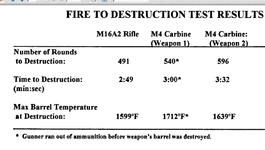- Messages
- 5,077
- Reactions
- 750
I'm with you Will.
They are both good to me. The AR's accuracy shows up at 100 yards and beyond. \
View attachment 203079
Upgrade to the new 580 series Mini-14 and you won't be able to tell the 2 targets apart.

Follow along with the video below to see how to install our site as a web app on your home screen.
Note: This feature may not be available in some browsers.
I'm with you Will.
They are both good to me. The AR's accuracy shows up at 100 yards and beyond. \
View attachment 203079

They are both reliable IMO. I've had both barrels white hot numerous times.
WHITE WHITE HOT!! SMOKING!!! YEP)))) I used to do it all the time! The Mini has the AR beat on this experience too. That is for sure!

Final Report = "Fire To Destruction Test of U.S. M4A1 Carbine & M16A2 Rife Barrel(s)" - M4Carbine.net Forums
this is what it takes to make a barrel begin to glow red hot, and the result, in 4150CMV steel. almost as soon as it begins glowing, it droops.. and once it droops, kB follows almost immediately.

1600 degrees is well below "white hot", which fluctuates between steel series, but is generally around 2190 degrees fahrenheit.. which is basically melting point.
the barrel will begin to radiate brown/red light at as little as 1110dF, but it's such a low output that you'd only be able to detect the glow in pitch black with adjusted sight. the handguards/stock will probably begin to melt/warp/burn, if they havent already. any wood would have ignited somewhere around 700dF. at about 1400, when the barrel softens to a malleable state, you might begin to see a glow in ambient daylight.. by this point, you're altering the composition of the steel simply by exposing it to air, and rounds sent down the bore will begin to deform your rifling. by 1600 degrees, the barrel is rapidly deforming.. the barrel is glowing brightly cherry red about 4" in front of the bolt face.. rifling is most likely completely gone. assuming devine forces keep the barrel from rupturing- by 1800 degrees the barrel is glowing orange, and is probably being stretched out by every round fired. it's no longer capable of containing the probably close to 80,000 PSI every fired round is now generating (from around 55,000 PSI at cold), but assuming devine intervention- by 2000 dF, the barrel is now a bright yellow, and most people would probably call it "white hot," though it still isn't "white" by the Forgers Color Chart standard... but it is now about the consistency of firm clay. keep in mind, most of the color change is probably still isolated to the area directly in front of the chamber.. i doubt any great color change would ever occur forward of the block. by 2200, the steel is now "white hot," and the is about the consistency of chewed bubblegum... any hotter, and it will be a readily pour-able liquid.

i've always been sort of puzzled by how gas tubes hold up.. having run a FA test, you've probably seen tube sag during extended FA fire- how the crap do those little steel tubes keep from popping? you'd think if it's soft enough to sag, it'd be soft enough to rupture under the 10-15k PSI flowing through those things.
do you have a report from the FA test? what was the firing schedule? was that a .gov endeavor?
Though, I hear the newer Mini 14's are far more accurate. Wouldn't mind shooting a new one. I really like them except for the inferior performance of the three I've owned
Ok, I'll throw this one out to any of you mini experts. Not having owned one, what exactly is the issue with the early mini's. Is it the barrel alone or are there other issues with the early ones. I have heard them discussed by series, ie 180 or 181 series (I assume that refers to production dates by the sn) Is the 180 series a total basket case ?
Reason I ask is I have an option to pick up an early model for a fairly low investment. From what I am reading from some of you they rank about the same as an SKS.
I have owned 3 different mini-14's. The mini is fun to shoot but it is no match for the AR.
The AR is hands down much more accurate and more versatile. I have sold all the Mini's and presently own 5 AR 'lowers' and 7 AR 'uppers'. Three for NRA High Power Rifle competition. Which shoots out to 600 yards. The AR service rifle presently completely dominates High Power Rifle competition. I own a Colt, Rock River (2), Bushmaster and a Smith and Wesson. They are all good lowers I would recommend the Rock River.

Here is where you will find all the Mini-14 answers you could ever have.
PerfectUnion BBS - Powered by vBulletin